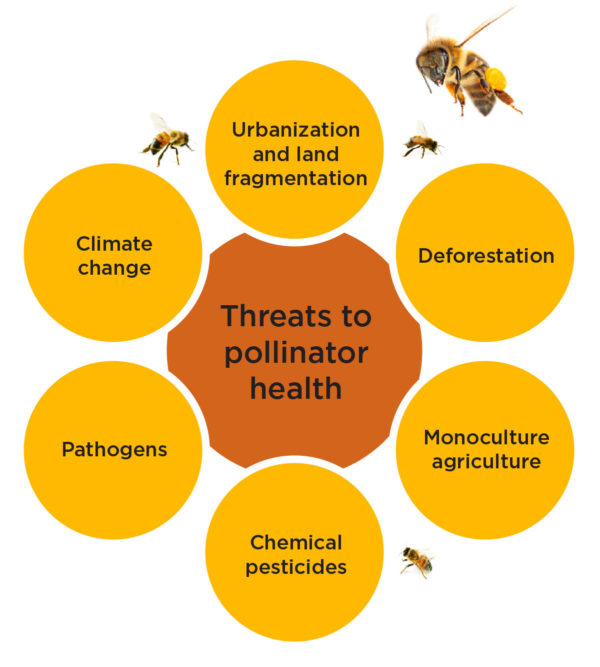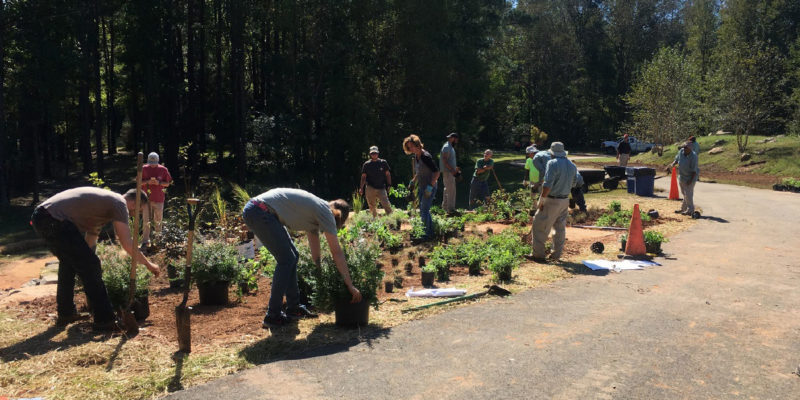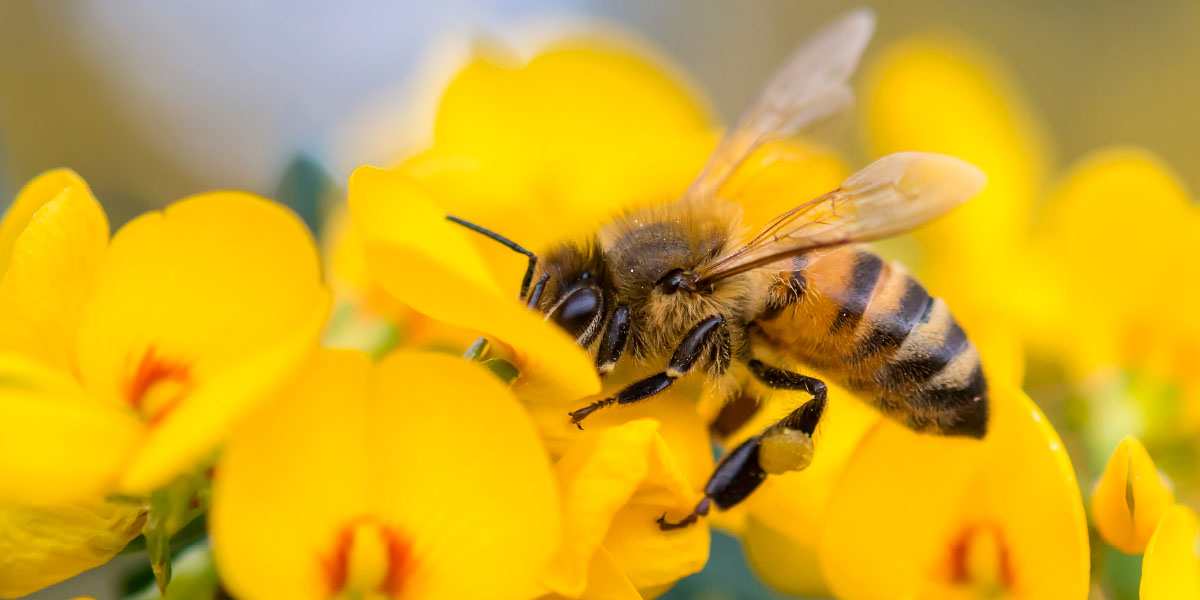
Pollinators are essential to the fabric of life on Earth. Simply by transferring pollen from one flower to another, these insects and animals enable fruits and seeds to grow, thereby providing a crucial service to human food production. Ecological communities worldwide also depend on their services. Pollinators are truly foundational to the global food web.
Unfortunately, the relationships among people, plants, and pollinators are under serious threat from multiple stressors in our changing world. Populations of insect pollinators are declining worldwide, and it is likely that many of these species either have already or may soon become extinct. The loss of pollinator services and the corresponding damage to dependent plants and animals will have significant negative ecological and economic impacts reaching from the fields to our grocery store shelves. Can you imagine life without apples, blueberries, or pumpkins? Even fast food needs pollinators: Dairy and meat livestock eat alfalfa flowers, which require pollination; and French fries depend on vegetable oilseed pollination.
The plight of pollinators has successfully captivated public attention in recent years, especially thanks to the popularity of the charismatic honeybee. In 2014, former U.S. President Barack Obama created the Pollinator Health Task Force to compel America to action through federal leadership.
The resulting National Strategy to Promote the Health of Honeybees and Other Pollinators called for bolstering honeybee and monarch butterfly populations and supporting native pollinator species by planting 7 million acres of enhanced habitat by 2022 and increasing public edu-cation on the subject. The national strategy was targeted at governmental agencies and institutions; however, American citizens have also answered the call by planting pollinator habitat, changing their landscape maintenance practices to better protect insect biodiversity, and spreading the word widely. And, it turns out that colleges and universities are uniquely poised to lend a helping hand to pollinators.
Made-to-Order Habitat
Two significant facts stand out when it comes to pollination opportunities for higher education. First, large institutional land holdings have immense potential for boosting pollinator habitat acreage nationwide in alignment with the national strategy. From formal landscaping around the campus quad to marginal areas such as mowed roadsides, public institutions in the U.S. maintain millions of acres that could be harnessed for pollinator support. Campus pollinator habitat can fit in diverse areas, including rooftops, greenways, power cuts, and even agricultural hedgerows.
But building brand new gardens isn’t necessary—campuses can also simply select pollinator-friendly tree and shrub species to add to their existing landscapes. Management practices can also be re-examined to better support pollinators. For example, integrated pest management techniques that strive to avoid harming pollinators can be applied to existing campus landscapes.
Second, the educational resources of colleges and universities can greatly support the pollinator cause. For example, academic courses, research projects, service learning projects, extension services activities, and special events can all be mobilized to spread pollinator awareness to students and surrounding communities. Academic departments focused on natural sciences are key partners, as are the grounds department and sustainability officers. Student organizations are also likely partners. And don’t forget social media. The opportunities are endless.
Sharing Support Strategies
Many colleges and universities are already standing up for pollinators, both on campus and in the classroom. From coast to coast, schools are introducing new plants into their landscapes, adopting friendlier pest management practices, and engaging the student body. North Carolina State University (NC State), Raleigh, is one example of a strongly engaged campus. As one of two land-grant universities in North Carolina, the agricultural tradition at NC State already supported pollinators academically through scientific courses and research. Inspired by the activities at the nearby University of North Carolina, Asheville, NC State has added additional pollinator-friendly activities in recent years:

Pollinator habitat. The NC State facilities division grounds management department maintains over a dozen pollinator plantings around campus, including around residence halls, at the art museum, along a side road, on the disc golf course, and more. NC State is also home to four honeybee hives around campus.
Education. In 2017, NC State hosted its first ever Pollinator Education Week, in partnership with the Office of Sustainability. Six events targeted at engaging students took place, including an information fair, a movie screening, and a garden cleanup project. Several hundred students directly engaged in these events, and likely thousands more were indirectly affected through publicity efforts and social media.
Awareness. The NC State Office of Sustainability maintains a website highlighting all the pollinator activities on campus, from student organizations to scientific research. The site also includes a map showing the locations of all the pollinator habitats mentioned here.
Financing for the Future
Through these activities, NC State has learned several valuable lessons. Sustaining pollinator habitat requires staff training and dedicated labor hours. Communicating effectively with boots-on-the-ground labor is also necessary.

Most importantly, it is crucial to allocate sufficient financial resources. A recent online survey of 55 North Carolina colleges and universities found that very few schools presently have coordinated financial management of pollinator efforts. Most respondents (66.7 percent) used their general operating budget to finance pollinator projects. Zero respondents reserved funding through specific budget line items. For outside sources of funding, 19.1 percent received private gifts; 16.7 percent used grants; and 4.8 percent engaged a corporate partner.
There is, however, ample opportunity for campuses to expand these creative funding sources. Grounds maintenance departments should connect with potential campus partners to seek out funding opportunities, such as the development office, sustainability office, horticultural science department, or other relevant entities. Here are some possible funding sources to consider:
- General operating budget of groundskeeping department.
- Specific line item or fund in groundskeeping budget.
- Private gifts from individual donors—reach out to your institution’s fundraising or development office to establish a way for donors to contribute to that specific fund.
- Public moneys for stormwater management, reforestation, removal of invasive species, and other ecological remediation efforts.
- Grants from public or governmental institutions and nonprofits supporting pollinators or more general environmental causes.
- Partnerships with private institutions or local businesses—consider enterprises dependent on pollinators, such as cosmetic companies that rely on beeswax, food companies that use honey, or horticultural and agricultural industries.
Strategies for Today
Institutions of higher learning are leaders in building public understanding of crucial issues facing our society. Pollinator protection is no exception. North Carolina is certainly not the only university system engaging with pollinators—this type of landscaping is becoming a norm at colleges and universities.
There is still room for growth. Pursuing new and different ways to protect pollinators in accordance with each schools’ unique goals and priorities, we recommend that colleges and universities undertake the following strategies to positively impact pollinators:
1. Think outside the flower box: consider selecting pollinator-friendly tree, shrub, and even grass species for all new plantings on campus. Trees can support incredible biodiversity at a much greater scale than a few flower blossoms.
2. Install signage that labels or interprets pollinator-friendly habitat. Even for one small patch of native flowers, communicating the purpose of the planting to passersby will increase impact. Plus, signage helps assuage any dissatisfaction should the area appear "messy" in the off-season.
3. Create a web presence documenting pollinator-friendly initiatives. Consider including a map of your pollinator plantings, pictures and news articles, and links to additional resources.
4. Create a written pollinator-friendly landscaping policy. Gather all the important stakeholders together to discuss and decide on priorities and goals—then commit them to writing. Plan to revisit this document in a year or two to evaluate your progress.
5. Pursue stable funding to support pollinator habitat maintenance and educational events. Internal funding, grants, donations, and corporate gifts are all potential funding sources. Reach out to your fundraising or development office to begin the conversation.
MELISSA TINLING is a graduate student in horticultural science at North Carolina State University, Raleigh.


